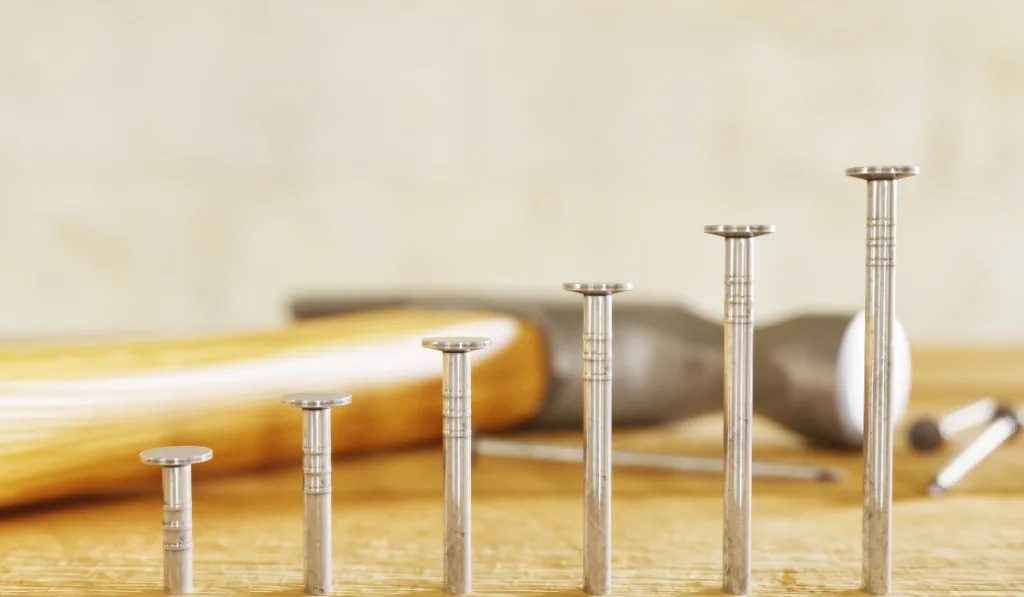*This post may have affiliate links, which means I may receive commissions if you choose to purchase through links I provide (at no extra cost to you). As an Amazon Associate, I earn from qualifying purchases. Please read my disclaimer for additional details.
The length of your roofing nails is a vital part of how strong your roofing installation is. But can roofing nails be too long? Let’s find out.
Can roofing nails be too long?
Roofing nails can be too long.
Generally, roofing nails should only be long enough to run through the roofing material and 0.75 inches (¾ inches) into the deck material. But when the nails are too long, they penetrate the whole length of the roofing and deck material. As a result, you will see them exposed in the attic.
The general standard favors not having roofing nails protrude through the roof deck. However, it still happens; roofing nails sometimes extend beyond the roof sheathing. Sometimes it’s undesirable, and sometimes, it isn’t a problem.
Below, we shed more light on whether roofing nails can be too long. We also provide answers to various other roofing-nail questions. Read on for more.

Table of Contents
Can Roofing Nails Be Too Long?
As said already, roofing nails can be too long.
The standard recommends that roofing nails only penetrate the roofing material and ¾ inches of the roof sheathing. Anything beyond this could mean that your roofing nails are too long.
The primary problem with roofing nails being too long is water leaks. In winter, frost will collect on the nails, and water will drip into the structures beneath the roof sheathing as it melts.
Interestingly, while the general standard ensures that roofing nails do not penetrate the entire length of roof sheathing, some local building codes may differ.
Some codes recommend having nails that extend ½ inches beyond the roof deck.
The said recommendation holds because nails hold the roof better when they extend beyond the roof sheathing. This is especially true when roofers bend the extended portion of the nail 90 degrees.
In cases where the building code recommends letting the nail extend beyond the roofing sheath, roofers prefer certain nail types, such as ring-shank nails.
When ring-shank nails penetrate wood and roofing materials, the wood fiber or roofing material fiber encloses around their grooves. This gives them superior holding strength and a tight hold even in moist conditions.

Ring-shank nails hold the roofing material down better. And they have minimal chances of water leaks even when they extend beyond the roof deck.
Besides using nails like ring-shank nails, roofers cover exposed nails to prevent water leaks.
They could cover the nails with a small piece of shingle. They could also use a dot of roof sealant covered in sand or granules.
The bottom line is roofing nails should ordinarily not be too long. However, some building codes and personal recommendations favor letting them be too long for extra hold.
Nonetheless, when roofing nails are too long, a roofer must ensure that there are no water leaks through the nail holes. Roof sealants typically come in handy for this purpose.
How Long Should Roofing Nails Be?
The ideal length of roofing nails for your project depends on various factors.
These factors are:
- The thickness of the shingles or roofing material
- The number of shingle or roofing material layers
- The thickness of the roof sheathing
Generally, if using a single shingle layer on a ½-inch roof deck, the roofing nails should be at least 1 ¼ inches long.
But if you are laying a new shingle layer atop the old shingle layer, you will need longer nails. Some recommend using 2-inch roofing nails, but 1 ½-inch nails might be long enough.
The southern parts of the United States typically do not experience heavy snow. This makes it possible for them to use thinner roof decks.
So, if you are roofing in a southern state, you may find that their local building codes allow you to use roof decks that are ⅜ inches thick.
When using ⅜-inch roof sheathing on a layer of shingle, 1-inch roofing nails will suffice. But if you are laying shingles over an old shingle layer, you should use roofing nails 1 ¼ or 1 ½ inches long.
Roofing Nail Diameter

At the least, roofing nails should be 12 to 11 gauge.
In other words, their nominal shank diameter should be no less than 0.11 to 0.12 inches. Nails with smaller shank diameters may not hold the roof well enough.
The minimum head diameter for roofing nails is ⅜ inches. Anything lower may not provide enough holding power for your roof.
When choosing roofing nails, pay attention to length and diameter and the texture of the shank.
Roofing nails with ribbed shanks have better holding power than those with smooth shanks.
Also, pay attention to corrosion resistance while choosing roofing nails.
Galvanized nails are less likely to corrode or get weaker. Of course, if your roofing nails do not lose strength through corrosion, they can maintain their holding power for longer.
Should Roofing Nails Be Visible in Attic?
Roofing nails should penetrate at least ¾ of an inch of a roof deck. However, if the roof deck is less than ¾ inches thick, the nails only need to travel at least ⅛ inch through the wood.
Going by the above, roofing nails do not necessarily have to be visible in the attic. However, if you want, you may make them visible in yours.
When roofing nails penetrate through the roof deck and become visible in the attic, their holding power is higher. This is especially true when you bend the visible nail parts to form a hook that holds the nails down.
If the extra holding power is vital to your installation, let your roofing nails be visible in the attic. But if it isn’t, just ensure the nails travel deep enough into the roof sheathing.
If your roofing nails penetrate the roof deck and become visible in your attic, there’s a chance of moisture leak. Conversely, if your roofing nails do not extend beyond the deck, there’s a chance the shingles will pop, leak, or blow off. So, consider your choice thoroughly.

12 Tips for Nailing Roofs
When nailing roofs, the following tips will help ensure high-quality performance:
- Do not use nails that are too short. If you do, you may have to deal with roof leaks or loosened shingles.
- Work with the nail type, grade, and size recommended in the shingle installation instructions.
- Ensure the nail penetrates the wood and shingle in a straight path. Also, ensure the nail head aligns with the plane of the shingle.
- Arrange the shingles correctly so that they cover the nails of the shingles above.
- Use just enough nails per shingle. Do not use fewer nails than recommended.
- Ensure you place the nail at the right spot on the shingle.
- When nailing shingles, start on one side and move towards the opposite side. Doing this ensures that the shingles remain flat and straight.
- Do not position your nails in existing holes or cracks. If you do, they will not have as much holding power as you expect them to.
- When nailing the shingles, be gentle while hammering the nails to avoid breaking the shingles. If you crack the shingles, you compromise the roof.
- Use corrosion-resistant roofing nails. Roofing nails are in a position where they have high exposure to the elements. So, they will readily break down, become weaker, and lose holding power if they are not corrosion-resistant.
- Fix nailing issues as soon as you can.
- Ensure you go through and adhere to the local building codes.
Nailing Defects With Shingles
Shingles typically suffer two nailing defects:
- Misaligned nails
- Overdriven nails
Misaligned Nails
When installing your roof, you must nail the shingles appropriately. If you don’t, the shingles may not hold themselves well enough.
Generally, the optimal position for nails on shingles is 1 inch above the edge and 1 inch from the cutout.
For Cambridge shingles, the best nail position is the nailing zone. If you run your nail through the nailing zone, it will hold down the shingle below at its upper edge.
Overdriven Nails
Avoid driving your nails too deep into the shingles when installing your roof. If your nails penetrate deeply into the shingles, you may lose the product’s warranty.
Besides losing warranty, overdriven nails are more likely to let moisture in or allow the shingles to come off.

Why Do Roofers Use Nails Instead of Screws?
Roofers may prefer nails instead of screws for various reasons. One of those reasons is flexibility.
Nails are generally more flexible than screws; they are less likely to crack under pressure.
Roofers may also prefer nails instead of screws because of the ease of hammering them in.
Many years ago, there were no automatic screwdrivers. So, if you were going to use screws for your roof, you’d have to drive them in using a manual screwdriver. Hammers were faster at driving nails than manual screwdrivers with screws. So, people preferred nails.
Final Thoughts
Roofing nails can be too long. Nails that are too long could leave your roof with structural flaws, and it could help improve holding power. So, depending on what you want, you may make your roofing nails too long or just long enough.
Resources
- https://www.quora.com/Can-roofing-nails-be-too-long
- https://mt-rca.org/roof-types/should-roofing-nails-be-exposed.html
- https://www.iko.¾/en/blog/proper-nailing-essential-performance-roof-shingles
- https://structuretech.com/short-shingle-nails/
- https://www.thehulltruth.com/dockside-chat/507732-how-long-should-roof-nails.html
- https://www.bobvila.com/articles/nails-vs-screws/
- https://www.popularmechanics.com/home/tools/how-to/a18606/nails-vs-screws-which-one-is-stronger/
